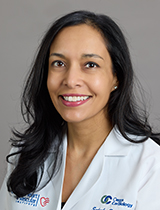Heart disease looks different for women — and pregnancy can increase your risk

Women of all ages can take steps to lower their risk of heart disease, heart attack and stroke.
May is Women’s Health Awareness month — a time to learn more about women’s health risks and needs.
One place to start is by finding out how heart disease can look different in women. The more you know, the better you can take care of yourself. Knowing the signs can also help you care for the women in your life.
First things first. What is heart disease?
There are several kinds. If your arteries (the blood vessels that carry blood to your heart and brain) get too narrow or blocked, it’s called atherosclerosis. This condition can lead to chest pain (angina), a heart attack or a stroke. Other heart conditions can affect your heart's muscle, valves or rhythm.
Women’s risks are different
“Heart disease is often thought of as a man’s disease, but it is the leading cause of death for women in the U.S.,” says Sudeshna Banerjee, MD, an interventional cardiologist at PeaceHealth in Springfield, Oregon.
If you were born with a female reproductive system, protecting your heart health starts with knowing your health risks.
Pregnancy
Many people experience complications when they’re expecting a baby. Some of the most common ones increase the risk of heart concerns during pregnancy and later in life. These include:
- Preterm delivery: Having a baby before 37 weeks of pregnancy can trigger inflammation in your body. This puts you at higher risk of developing a heart condition in the future.
- Preeclampsia: If you develop high blood pressure during pregnancy, you’re more likely to have high blood pressure, heart disease, stroke and blood clots in your legs. Some of these risks can last for up to 14 years after giving birth.
- Gestational diabetes: If you are diagnosed with diabetes during pregnancy, you have a higher chance of getting type 2 diabetes later in life. Your risk of stroke or heart attack goes up, too.
Menopause
In middle age, most women go through menopause — the time after your monthly periods stop. After menopause, women’s risk of heart disease goes up. This is because your body makes less of the female hormone estrogen, which can lead to increased cholesterol. High cholesterol can cause atherosclerosis.
Other heart health risks
Do any of the items in the lists below apply to you? If so, read on to learn about symptoms to watch for.
Health risks for men and women | Health risks for women |
|
* Men can have this, but it’s more common for women. |
Women’s symptoms can be subtle
“We see symptoms for heart attacks on TV, and people often think that’s what will happen — a person has crushing chest pain and gets sweaty,” says Dr. Banerjee. “For women, a heart attack can feel different in many ways.”
Here are some of the things you might experience:
- Fast or irregular heartbeat
- Sweating
- Lightheadedness
- Pain in the chest on either side
- Pain in the back, especially between the shoulder blades
- Shortness of breath
- Left arm pain
- Nausea only
- Jaw pain
- Extreme fatigue
Nausea can be a surprising symptom in women. “I’ve seen women really surprised when they visit the ER for nausea, and tests show evidence of a heart attack,” Dr. Banerjee says. “It’s important for women — and their families — to know that nausea can be the only symptom.”
Shortness of breath is also easy to overlook, but it is a major symptom in women. “Sometimes I hear women say, ‘I feel like I am just getting old’ when they experience an increase in fatigue or shortness of breath in just a few weeks or months,” Dr. Banerjee adds. “For an increase to come on so quickly is not a normal sign of aging, and often the first signs of angina.”
Knowing what to look for and when to act can save a life. If you have symptoms of heart disease, or notice someone else experiencing them, call 911 right away.
When you call, the operator may recommend chewing one adult-strength or two to four low-dose aspirin to get the medicine into your bloodstream quickly. Wait for an ambulance. Don’t try to drive yourself.
Taking care and taking action
While women have different heart health risks, there’s a lot you can do to lower your chances of a heart condition. Here are some ways to keep your heart as healthy as possible:
- Check your blood pressure regularly and try to keep it at healthy levels.
- Get screened for diabetes.
- Quit using tobacco. If you don’t smoke, vape or chew, don’t start.
- Lose weight if needed. Even a few pounds can help.
- Check your blood cholesterol and triglycerides.
- Prioritize healthy eating.
- Limit alcohol to one to two drinks a day.
- Manage your stress levels.
- Exercise two to three times a week.
A great place to start on the path to better heart health is with a talk with your primary care provider. “Your PCP can help you understand if you have risks for heart problems and refer you to a heart specialist if you need one,” Dr. Banerjee says.
Have an honest conversation about your physical activity, blood sugar, cholesterol and blood pressure. Once you have solid information about your individual situation, you can take action.
If you don’t have a PCP, we can help you find someone. See who’s accepting new patients in your community.






